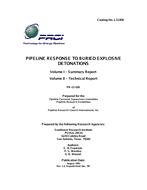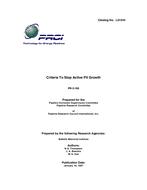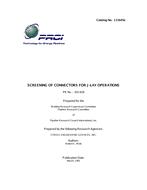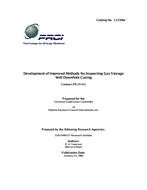Provide PDF Format
PRCI PR-15-109
- Pipeline Response to Buried Explosive Detonations
- Report / Survey by Pipeline Research Council International, 08/01/1981
- Publisher: PRCI
$548.00$1,095.00
L51406e
Southwest Research Institute
Volume I Summary Report - 44 Pages
Volume II Technical Report - 265 Pages
Need: Occasionally buried explosives are used within proximity of "in-service" pipelines which increases the stresses in the localized section of pipeline near the explosion which may result in pipeline failures. A procedure was needed for predicting the maximum stresses in steel pipelines induced by nearby, buried, explosive detonations.
Result: An extensive experimental and analytical program were funded and performed by the Southwest Research Institute over a six (6) year period 1975-1981. The program was divided into two (2) parts: In the first part, similitude theory, empirical analyses and test data were used to derive equations for estimating maximum ground displacement and particle velocity. The ground motions provided the forcing function imparted to a buried pipeline. In the second part, similitude theory, conservation of mass and momentum, and approximate energy methods were used to derive functional relationships for the maximum pipe strains and stresses. Experimental data from more than sixty (60) field tests ere used to develop equations for estimating maximum pipe stresses induced by point and parallel line explosive sources buried in homogeneous soil media. The pipe stress and ground motion data from these experiments were used to develop an equation for computing an effective standoff distance so that the point source soil equations could be used to approximate the pipe response. The large amount of data used and the wide range of these data make the solutions applicable to most blasting situations near pipelines.
Benefit: This report provides comprehensive and detailed information for pipeline operators to predict the effect of buried explosives and thus the safety of a pipeline section while in-service through proper assessment of stresses and guidelines for the appropriate selection of explosive charges, techniques and methods. This will avoid unexpected operational costs, provide guidance for "operator qualification" for pipeline blasting of in-service pipelines and minimize liabilities to the operator. This study has been used by Pipeline Research Council International, Inc. (PRCI) member companies to generate company standards and procedures related to in-service blasting nearby pipelines.
Southwest Research Institute
Volume I Summary Report - 44 Pages
Volume II Technical Report - 265 Pages
Need: Occasionally buried explosives are used within proximity of "in-service" pipelines which increases the stresses in the localized section of pipeline near the explosion which may result in pipeline failures. A procedure was needed for predicting the maximum stresses in steel pipelines induced by nearby, buried, explosive detonations.
Result: An extensive experimental and analytical program were funded and performed by the Southwest Research Institute over a six (6) year period 1975-1981. The program was divided into two (2) parts: In the first part, similitude theory, empirical analyses and test data were used to derive equations for estimating maximum ground displacement and particle velocity. The ground motions provided the forcing function imparted to a buried pipeline. In the second part, similitude theory, conservation of mass and momentum, and approximate energy methods were used to derive functional relationships for the maximum pipe strains and stresses. Experimental data from more than sixty (60) field tests ere used to develop equations for estimating maximum pipe stresses induced by point and parallel line explosive sources buried in homogeneous soil media. The pipe stress and ground motion data from these experiments were used to develop an equation for computing an effective standoff distance so that the point source soil equations could be used to approximate the pipe response. The large amount of data used and the wide range of these data make the solutions applicable to most blasting situations near pipelines.
Benefit: This report provides comprehensive and detailed information for pipeline operators to predict the effect of buried explosives and thus the safety of a pipeline section while in-service through proper assessment of stresses and guidelines for the appropriate selection of explosive charges, techniques and methods. This will avoid unexpected operational costs, provide guidance for "operator qualification" for pipeline blasting of in-service pipelines and minimize liabilities to the operator. This study has been used by Pipeline Research Council International, Inc. (PRCI) member companies to generate company standards and procedures related to in-service blasting nearby pipelines.
Related Products
PRCI NG - 18 Report 167
Surface Effects on Stress Corrosion Susceptibility of Line Pipe Steels..
$48.00 $95.00





